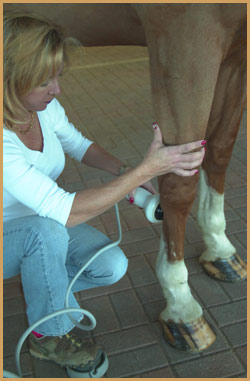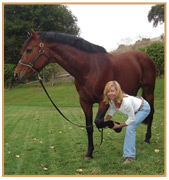
Jenny E. Johnson, V.M.D. Calabasas, CA (818) 809-SHWV (7498) (818) 878-9458 - fax equineshockwave.com |
||
| In This Issue | ||
• Main Story • Tell a Friend • About Dr. Johnson |
||
| Ask Dr. Johnson | ||
Dr. Johnson is available to answer any questions you may have. Simply click here to email your questions directly to her. |
||
| Tell a Friend | ||
Share a wealth of veterinary knowledge with your friends and colleagues. Click here to forward this email. |
||
 |
| June 2008 | |
| Suspensory Ligament Injuries |
|
 Suspensory ligament injuries are common in sport horses. They may present as a sudden onset of severe lameness or as a more gradual onset of mild lameness. Inflammation of the suspensory ligament is referred to as suspensory desmitis. Injuries to the suspensory ligament may or may not be associated with swelling or pain on palpation. Diagnosis will usually be made through a combination of clinical signs, diagnostic nerve blocks and ultrasound examination. Suspensory ligament injuries are common in sport horses. They may present as a sudden onset of severe lameness or as a more gradual onset of mild lameness. Inflammation of the suspensory ligament is referred to as suspensory desmitis. Injuries to the suspensory ligament may or may not be associated with swelling or pain on palpation. Diagnosis will usually be made through a combination of clinical signs, diagnostic nerve blocks and ultrasound examination.Shockwave Therapy and Suspensory Ligament Injuries Shockwave therapy can be an important component of the treatment of the suspensory ligament. It can be used to treat acute or chronic injuries, including mild strains, inflammation, and actual tears of the suspensory ligament. Shockwave therapy plays a role in a number of metabolic processes that are important in the healing process. It stimulates new blood vessels to grow into the affected area and causes numerous growth factors that are important in the healing process to come to the area of injury. It has been well documented that shockwave therapy will cause naturally occurring stem cells that are in the horse’s body to migrate to the site. Additionally, it is thought that shockwave therapy will stimulate the formation of fibroblasts, cells that play a necessary role in tendon and ligament repair. It also has a potent anti-inflammatory affect. All of these factors combine to make shockwave therapy especially helpful in treating injuries of the suspensory ligament. Acute vs. Chronic As with most injuries, the sooner a suspensory injury is treated the better the chance of a successful outcome. While mild suspensory injuries may heal with the conservative protocol of stall rest and hand-walking, adding shockwave therapy to the treatment plan increases the success rate. This is especially true in hindlimb suspensory injuries. Hindlimb suspensory injuries generally carry a fairly poor prognosis for return to athletic function. Using shockwave therapy to treat these cases can result in a significantly improved prognosis and a higher success rate. Chronic suspensory inflammation and pain can also be treated with shockwave therapy. In many cases, an injured suspensory will reach a plateau in the healing process in which the horse does not seem to improve for an extended period of time. Shockwave therapy can be helpful in these cases to “jump-start” the healing process. It can also be used to manage a horse that has persistent inflammation associated with the suspensory ligament. These horses can frequently be kept in competition with a maintenance schedule of shockwave therapy. Over time, in many cases, the inflammation in the suspensory will decrease and the ligament may become more normal in appearance. Treatment Protocol The “typical” protocol for treating suspensory injuries is a series of three treatments spaced at 3 week intervals, with a follow up ultrasound exam approximately 4 weeks after the last treatment in order to gauge the stage of healing. In more severe forelimb injuries and hindlimb suspensory injuries, several additional treatments may be necessary. In the cases of chronic suspensory inflammation, these horses generally benefit from a regular maintenance schedule of shockwave treatments tailored to the individual horse’s work and competition schedule. Each individual horse’s treatment regime is specific to that horse and his or her specific condition. A horse that has no identifiable lesion on ultrasound but has inflammation in the suspensory (desmitis) may be able to successfully continue working and competing with judicious use of shockwave therapy and careful monitoring. On the other hand, a horse with a clear defect in the suspensory will need to have a period of stall confinement with a gradual increase in controlled exercise in combination with the shockwave therapy. In acute cases, shockwave therapy can be very useful in reducing the swelling associated with an acute injury and thereby helping to minimize the disruption to the area that may be caused by significant inflammation. In each case, the treatment plan must be created for the individual horse. Shockwave Therapy and Stem Cell Therapy Frequently the question arises as to which treatment is better, shockwave therapy or stem cell therapy? Shockwave therapy has substantially more well documented research into its effects than does stem cell therapy, and shockwave therapy has the significant advantage of being non-invasive. In every case, the ideal treatment will be developed by the examining veterinarian and any consulting veterinarians. Shockwave therapy and stem cell therapy can be used in combination. Shockwave treatment can be done anytime prior to stem cell injection and then can be used 4 weeks or later after stem cell injection. Are All Shockwave Machines the Same? As always, it is important to remember that not all shockwave machines are the same. There have been a number of machines marketed as shockwave machines that do not actually produce a true shockwave, but rather a ballistic or radial wave. The physics of this type of wave are completely different from those of a true shockwave. This is important information when treating suspensory ligament injuries because the energy generated with a radial machine will largely be dispersed prior to reaching the suspensory ligament. The equipment used by Dr. Johnson is a Versatron, manufactured by Sanuwave. This is a true focused shockwave generator and is the same equipment currently being used in 18 veterinary teaching hospitals. |
|
| About Dr. Johnson | |
|
|
818-809-7498 | www.equineshockwave.com © 2008-2010 Oakhill Shockwave & Veterinary Chiropractic. All rights reserved. eNewsletter design by EquestriSol. |
|
